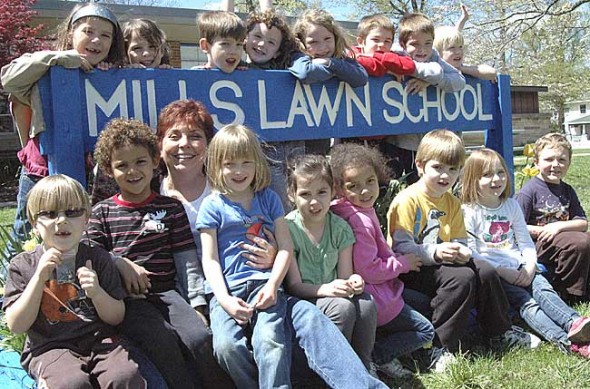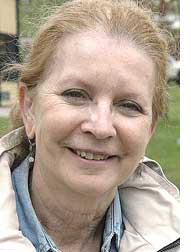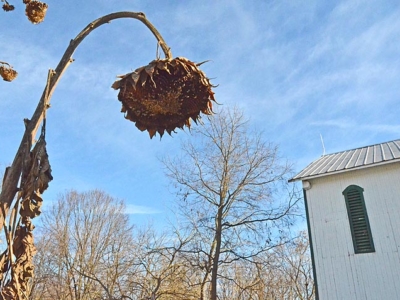
Reveling by her youths — Becky Brunsman, who has taught music and kindergarten at Mills Lawn School for nearly 40 years, will retire at the end of the school year. She and long-time P.E. teacher Jutta Galbraith, are featured together in a story on page 9. Three other long-time teachers in the district, who are also retiring this year, will be featured in next week’s News. Brunsman is shown here with her kindergarten class, including in back from left, Jaleigh Smith, Vivian Bryan, Io Palassis, Eliza Minde-Berman, Mya Jones, Ethan Knemeyer, Jason Knemeyer and Liam Cooney; in front from left, Liam McClean, Elijah Williams, Hailey Roe, Maya Kingsley, Isabella Blackwell, Joe Freeman, Parker Kidd and Tallis Onfroy-Curley. (Photo by Lauren heaton)
Teachers reflect on fulfilling careers
- Published: May 12, 2011
Five teachers from Mills Lawn Elementary School and Yellow Springs High School are retiring this year after more than 30 years in the district. This issue includes features on Mills Lawn kindergarten teacher Becky Brunsman and P.E. teacher Jutta Galbraith. Next week’s issue will feature YSHS history teacher Joyce McCurdy and physics teacher Phil Lemkau, and Mills Lawn intervention teacher Shanna Winks. YSHS P.E. teacher Kevin O’Brien was featured in January.
* * *
Whatever Becky Brunsman does, she does it big. It makes no difference that she’s spent most of the last 43 years teaching elementary students and kindergartners, the smallest of them all. In her eyes witnessing their learning to sing and read is one of the most thrilling things in life, and she has devoted hers to turning those “small” moments into giant musical celebrations of every child and his or her unique talents.
“Teaching has been the most rewarding job — every single day someone learns how to do something new or has an a-ha! moment,” Brunsman said in an interview at school last week. She gets to be there when one of her students loses a tooth, learns to tie a shoe or tenaciously sounds out a new word, like one kindergartner did last week at the Glen with the word “ha-b-it-at — habitat!” she said.
“After watching him chew on it and then sound out each syllable, I thought, yeah!…this is the stuff life is made of — this is the good stuff!”
Brunsman came to Mills Lawn after two years teaching second grade at Cedarville, which “was not a good fit,” she said. But in her first year as the general music teacher at Mills Lawn she dove headfirst into building what would become a 150-student “Centaurus Chorus” that performed in bank lobbies and public spaces all over the Miami Valley. She got support for her passion from Principal Randall Newsome and others, and she knew she had found the right place.
The growth of the chorus concerts was limited only by Brunsman’s capacity to manage 300 chaotic elementary-age children, whose energy level she said she can out-do any day of the week. “I can always match ‘em,” she said swinging her legs in an oversized chair.
One St. Patrick’s Day concert included hauling a piano in the back of teacher Mr. Roby’s pickup truck to accompany a marching band routine of “Step to the Rear” in Dayton’s Courthouse Square. Teachers and parents made silk screen t-shirts for every student, and though the performance was rather unconventional, the Centaurus singers won a prize and were featured on Channel 22.
“There was no way they were going to deny my 100-child chorus!” she said.
The concerts matured into all-school musical productions, beginning with Joseph and the Amazing Technicolor Dreamcoat. Then she figured if she could direct these shows, why not write them too? The result was Lost in the 50s, which included finding, recording and distributing all the music for rehearsals, sewing about 100 poodle skirts, getting someone to build a pink Cadillac and a flying saucer, and conducting a live band for the show. Brunsman remembers School House Rock, Aladdin, and others, but her favorite was On Broadway, which she also wrote and used to develop a timeline and cultural curriculum to teach the kids about the different periods of American history.
Everyone helped make the events happen, including parents, staff, teachers, administrators and their spouses as well as community members at large. “Nobody was safe,” Brunsman said of her recruiting powers.
Brunsman spent 13 years as the music teacher before adding on the role of head kindergarten teacher, which she managed to do for three years before letting go of the music teaching position. But that wasn’t all she was doing. In addition to the annual all-school concerts and writing artist-in-residence grants for Mills Lawn, she also began teaching courses on music for the classroom teacher at both the University of Dayton and Antioch College and directing musicals for the Springfield Civic Theater both in the summers and during the school year. Her husband, Alan, knows that Brunsman’s energy output capacity is close to superhuman.
“Alan always says that when I die, my adrenal gland should be donated to the Smithsonian,” she said.
Brunsman has always been a teacher, she said. In the ninth grade after she had achieved a certain proficiency with the guitar, she started offering $2 guitar lessons to her classmates. She has also always been a performer, tap dancing as a girl and participating in theater all through her school days. What she gained herself and what she has watched her students gain from their performance experiences convinces her of the importance of the arts in education. The all-school musical is the one legacy she hopes to leave behind as a venue where kids can gain confidence sharing their skills and working together toward a common goal.
“We find something for everyone with even an inkling of some kind of talent or interest, whether it’s movement, a comedy bit, or a love of roller skating,” she said.
Of all the content she teaches, and all the fun she and her students have, the most important skill she hopes to pass on is that of confidence.
“Kids need to be able to say, ‘yes I can’ and have the confidence to do things themselves,” she said.
She also wants her students to be strong readers. Even math geniuses need to be able to read to understand the problems they want to solve, she said. And she aimed to pass these things on mostly by letting her students explore their natural sense of curiosity.
“Yesterday we made carrot pudding, planted flowers, then headed over to Trailside for a hike in the Glen,” she said with a broad smile. “To me, that’s a perfect kindergarten day, where we learned lots and had our hands in the muck!”
While state academic standards for early childhood education have become more rigorous for kids, Brunsman cautions that the answer may be a simpler one.
“Early childhood education is great, but respect the early child,” she said. “You only get one shot at this childhood business. Let them be children — let them experience the joy and wonder of being a child.”
Brunsman’s love of teaching was topped only by her need to spend more time with her young grandchildren in North Carolina, where she will be able to travel more freely after she retires this year. But she plans to maintain a permanent residence in Yellow Springs, and likely won’t be able to stay away from school completely, she said.
Jutta Galbraith
Sometimes it’s the simplest games that excite students the most and keep them interested in moving and exercising. Mills Lawn physical education teacher Jutta Galbraith knows this about the kids she has taught in the community for the past 35 years. While she continues to read about and research new ways to involve students in gym class and to keep herself excited too, she always comes back to classics like dodgeball, the parachute game and variations on the game of tag.
Mills Lawn was the first school Galbraith taught at after graduating from Central Michigan University. It was a relatively unregulated part-time job then-Principal Randall Newsome hired her to do, right after asking her if she thought she could manage to occupy young kids with a variety of activities for several hours each day.
“Yeah, I said, I think I could do that,” she said.
So without a set of standards nor an established curriculum to follow, Galbraith went about designing her own program based on helping kids to develop motor skills, physical skills and cooperative skills. In 1990, several years after she had her own children, curricular standards for physical education became more defined, and Galbraith began teaching full time.
Galbraith has known she would be a P.E. teacher since the seventh grade, when she decided she liked her junior high school P.E. teacher enough to want to be just like her. She has not wavered from that conviction, and has a kind patience for many kinds of students who learn in very different ways. She bases some of her lessons on research by Jean Blaydes Madigan, who developed her trademark Action Based Learning methods to improve memory retention, reinforce academic concepts and help balance brain chemicals to help students to, for example, place words and letters on a page or to improve their reading retention.
Over the years Galbraith has developed a good sense of what motivates students. One activity that kids love and ask for again and again is “walking club,” which involves no more than a cone-lined walking course on the school yard and a heart-shaped charm that kids who walk five miles can collect and wear on their shoelaces. With each lesson, Galbraith talks to students about the benefits to particular systems in their bodies, such as the circulatory system, which is powered by the heart. The kids might retain some those lessons, but they also just love to move and be recognized for their achievements.
“Kids love it! They all know the walking club is a thing we do at the end of the year, and they sometimes ask, ‘Can we run?!’” she said. “Sometimes the simplest things are the ones that work.”
Galbraith has also learned that in order to make certain kinds of connections in the brain, kids who are still developing need to move their brains in different ways, such as rocking, spinning and shaking in different directions. The activity also helps kids to develop socialization skills, and Galbraith often designed partner activities to help kids learn to work with different people.
And for those who have more difficulty finding success, Galbraith is quick to remind students not to compare themselves with others but rather to do their personal best. If a student says, “I can’t do it,” and gives up trying, she tells them, “It’s not that you can’t, it’s that you just haven’t done it YET!”
Most activities can easily be connected to the curriculum, for instance, through reading and chanting rhymes in rhythm to jumping rope, or having the kindergartners pretend they are the running reindeer in Jan Brett’s story The Wild Christmas Reindeer. The younger grades get introduced to the simpler movements, such as skipping and galloping, which are then incorporated into slightly more complex games and dances for the older grades, including simple forms of line dancing, basketball and cooperative games.
Galbraith also makes up some of her games, including the popular “chickens to the rescue,” in which taggers try to freeze the runners, who can only be unfrozen by a runner with a plastic chicken, which must then be returned to the chicken coop. Another called “zoo keeper” involves hunters using a Nerf ball to tag the wild animals, who must then go to the zoo and act like they are trapped.
Galbraith remembers most the activities that involved working with teachers to design multi-disciplinary programs, such as the sixth grade course on Egypt, during which Becky Brunsman choreographed a dance and Galbraith taught it to the sixth graders to perform. She also has fond memories of her work with artists in residence such as the Bi Okoto African Dance group, modern dance teacher Margot Greenlee and Rhythm ‘n Shoes. She got involved with other academic projects by helping students, for example, to interpret through movement Native American stories and teaching them about the physics of propulsion while learning to ride scooters.
After she retires next month, Galbraith will stay in Beavercreek with her family to care for her aging parents and help with her grandson, and she hopes to do more gardening and travelling. She doesn’t feel a huge change coming on, just a shift of focus that after three decades was “meant to happen,” she said.















No comments yet for this article.